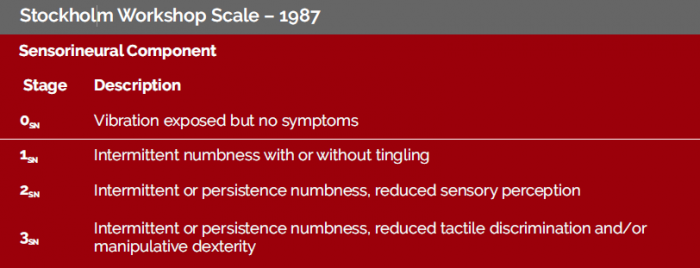The 5 Tiers of Vibration Health Surveillance
Part of the problem with the term HAVS (Hand Arm Vibration Syndrome) is that it uses the word syndrome, which immediately makes this sound like an illness. The first thing to understand
when embarking on health surveillance is that we are talking about injury, not disease, so medicalising it actually isn’t very helpful in bringing about more of an understanding in the workforce. It also doesn’t help with getting the health surveillance right in the first place.
Read on to learn about the 5 tiers to vibration health surveillance, or read our article: The Definitive Guide to Managing Hand Arm Vibration in the Workplace.

Health Surveillance is a vital tool in managing HAVS, and is a system that can be easily set up. The most crucial element of any health surveillance is to establish a baseline level. This simply
means that you must find out as soon as possible after commencement of employment the current condition of someone’s health in relation to had arm vibration.
The HSE have produced a guide for employers on how to set up and run a health surveillance programme which you can download here. The essence of the guide is reasonably straight forward and follows a 5 tier structure to vibration health surveillance.
The 5 Tiers to Vibration Health Surveillance
Tier 1
Baseline questionnaire (an example of which can be downloaded from the HSE website) which is designed to gather information about a person’s previous employment, any pre-existing health
issues relating to vibration exposure or anything that may cause greater susceptibility to HAVS.
Tier 2
This is an annual screening questionnaire, which is intended to monitor any changes over the baseline questionnaire and to highlight individuals that may need to be referred to Tier 3 for a HAVS health surveillance check.
Tier 3
A qualified person would normally conduct this health surveillance assessment, which can consist of a number of elements including the use of some of the equipment below. The person
conducting the test does not have to be medically qualified, but must have relevant training in the assessment of HAVS.
Hand Dynamometer
Hand Dynamometers can be used to measure and monitor grip strength, which in itself is not an indication of injury, but can be monitoring to gauge any changes of time.
Touch-Test Sensory Evaluators
Touch-test Sensory Evaluators can be used to monitor the nerve sensors at different points of the hand. These consist of tiny flexible filaments that can be drawn over the fingers to assess the sensitivity of touch. Once again, a change of this perception can be an indication of the progress of a vibration related injury.
Purdue Pegboards
Purdue Pegboards are used to measure and monitor dexterity levels, and are an industry standard method. Generally supplied with Purdue Pegboards are guideline levels for different age groups and genders, helping you benchmark your employees. Originating from the USA in the 1950’s as a means of determining the dexterity of potential manual workers for recruitment purposes, dexterity is also a factor that’s generally affected with injury from vibration and therefore it’s another important factor to monitor closely.
Tier 4
Tier 4 involves a formal diagnosis, which must be carried out by a medical doctor who specialises in occupational health – normally someone who is a member of the Faculty of Occupational
Medicine. This person would use information provided along with their own assessment to determine the scale of any injury. The scale used for diagnosis is called the Stockholm Scale and gives a rating for 2 elements of HAVS damage and is shown below:


A diagnosis to the Stockholm scale would be given in 2 parts such as 1SN3V, which shows the extent of injury for each component.
Tier 5
Tier 5: Is an optional set of tests that can be called up by an occupational Doctor in determining the formal diagnosis. These tests might include:
- Virbo-Tactile Threshold Test – a device that produces a vibration on a small plate at specific frequencies and levels. The patient has a response button and will press it when they feel the vibration at their fingertips, and release it when they cannot.
- Temperature Aesthesiometer – This device also uses a small plate, but warms and cools it to gauge the perception to changes in temperature at the fingertips.
- Fingertip Blood Pressure test – Just as it says, this is the blood pressure specifically measured at the fingertips.
- Hot-Cold Provocation Test – Not widely used but test the response to temperature using a bath of water that is warmed and cooled.
-

Castle Products
CLICK HERE FOR
Information, technical data, images and pricing of all Castle Group Ltd. products -

Product Rental
CLICK HERE FOR
Hire the best equipment at a fraction of the purchase price -

Calibration Lab.
CLICK HERE FOR
Calibration and repair services from Air Samplers to Vibration Meters -

Training
CLICK HERE FOR
World class safety and environmental courses. On your site or our 4* training facility -

Consultancy
CLICK HERE FOR
Employ our expertise for both simple and more demanding issues.












